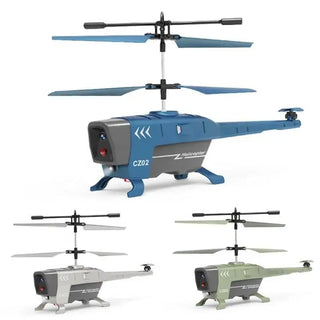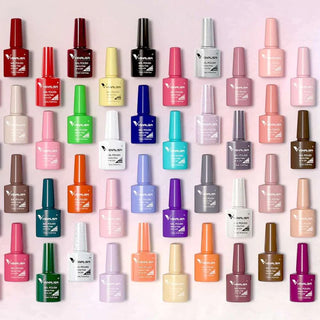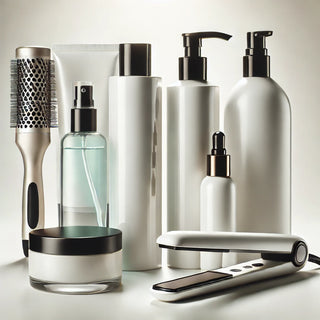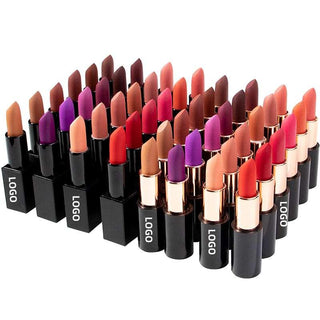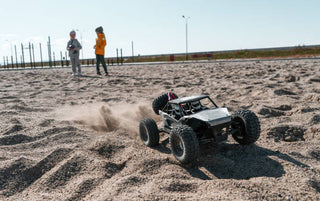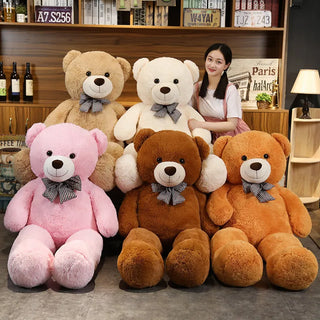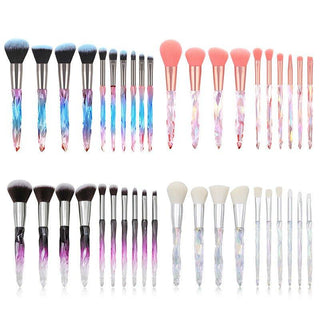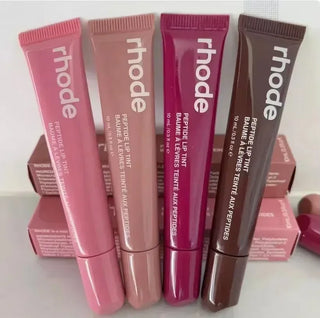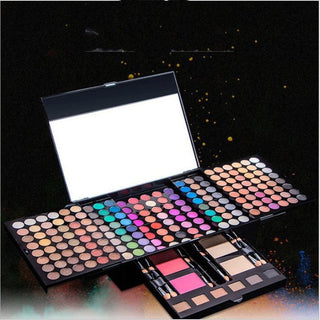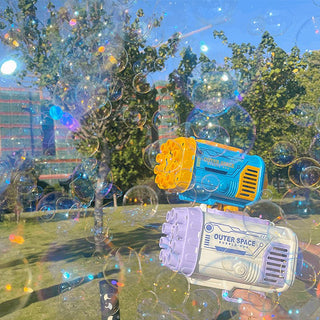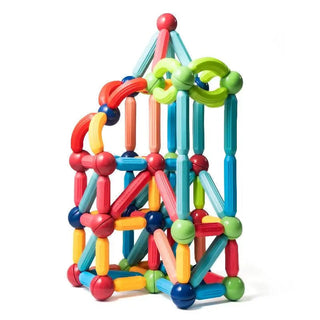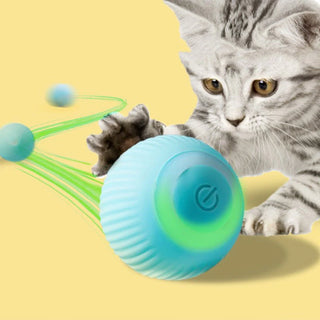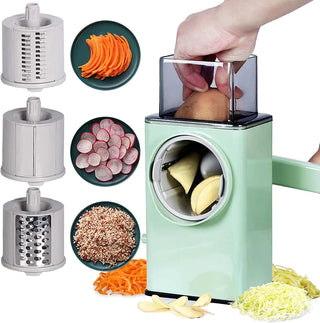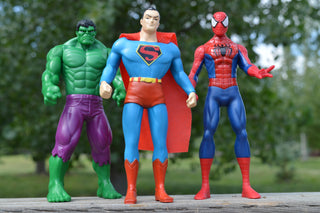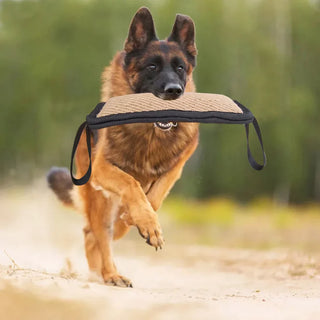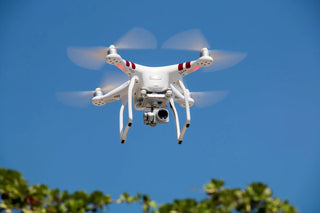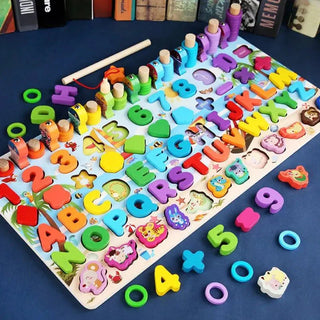Picking the right camera for your drone can feel like a big deal, especially with so many choices out there. It's not just about getting a drone that flies well; you also need to think about the camera it carries. This guide will help you sort through the important stuff, so you can find the best cameras for drones and get awesome shots every time. We'll look at what really matters when you're making your decision.
Key Takeaways
- Quadcopter designs are usually best for steady drone photos and videos.
- Crash-avoidance sensors are good to have, especially for new drone pilots.
- A quality camera means at least 12-megapixel photos and smooth 4K video.
- A three-axis gimbal is super important for keeping your footage stable.
- Long battery life helps you get more flight time and more shots.
1. DJI Air 3S
Okay, so the DJI Air 3S. Honestly, it's probably the best pick for most people looking for a drone right now. It's like they took the Air 3 and gave it a serious boost. The big deal is the improved obstacle avoidance and the better camera.
It's got two lenses, which is cool, but the real win is the LiDAR. That thing makes a huge difference when you're flying around stuff, especially in dim lighting. Plus, they upgraded the transmission system to Ocusync 4, so you get a more stable connection. Battery life? We're talking 45 minutes or more, which is pretty sweet. The main camera now rocks a 1" sensor, and that really helps when the light isn't great.
I was flying mine the other evening, and I was shocked at how well it handled the low light. I mean, I could actually see what I was filming! It's a game changer.
Here's a quick rundown of why it's so good:
- Better obstacle avoidance (LiDAR is awesome).
- Longer flight times (45+ minutes).
- Improved camera (1" sensor).
- Better transmission (Ocusync 4).
Honestly, if you're looking for a drone that's easy to fly, takes great video, and won't crash into everything, the Air 3S is a solid choice.
2. Quadcopter

When you're talking about drones, the quadcopter design is super common. It's basically the standard these days. You see them everywhere, from hobbyists flying in parks to professionals using them for serious work. What makes them so popular? Well, it's a mix of stability, maneuverability, and relatively simple construction.
The four-rotor setup gives them a good balance, making them easier to control compared to other multi-rotor designs.
Think about it: you've got two pairs of rotors spinning in opposite directions. This cancels out the torque, which means the drone doesn't just spin around uncontrollably. That's a big deal when you're trying to get smooth footage or navigate tight spaces. Plus, having four points of thrust gives you plenty of power for lifting cameras and other equipment.
Here's a quick rundown of why quadcopters are so popular:
- Stability: Easier to keep steady in the air.
- Maneuverability: Can move in all directions with good control.
- Cost-Effective: Generally cheaper to build and maintain than other designs.
- Payload Capacity: Can carry a decent amount of weight for cameras and sensors.
One thing to keep in mind is that while quadcopters are great all-arounders, they might not be the best choice for every single application. For example, if you need extreme stability in very windy conditions, you might want to look at a hexacopter or octocopter. But for most people, a quadcopter is going to be the sweet spot.
3. Crash-Avoidance Sensors
Okay, so let's talk about keeping your drone in one piece. Crash-avoidance sensors are a big deal, especially if you're new to flying or tend to get a little too adventurous. Basically, these sensors help your drone "see" the world around it and avoid running into things like trees, buildings, or even unsuspecting birds.
Having reliable crash-avoidance can seriously reduce the chances of a costly accident.
Think of it like this:
- Sensors act as the drone's eyes, using things like cameras, infrared, or ultrasonic sensors to detect obstacles.
- The drone's brain (flight controller) processes the sensor data to figure out where obstacles are and how to avoid them.
- The drone then automatically adjusts its flight path to steer clear of trouble.
Some drones have sensors only on the front, while others have them on all sides (front, back, top, bottom, and sides). More sensors generally mean better protection, but it also usually means a higher price tag.
It's worth noting that even with the best sensors, you still need to fly responsibly. Sensors aren't perfect, and they can be fooled by things like bright sunlight, reflective surfaces, or very small objects. Always keep your drone within your line of sight and be aware of your surroundings.
Here's a quick rundown of common sensor types:
| Sensor Type | How It Works ,
4. High-Quality Camera
When choosing a drone, the camera is a big deal, especially if you're planning to take photos or videos. You want a camera that can capture clear, detailed images and videos, even in different lighting conditions. It's not just about megapixels; sensor size, lens quality, and video resolution all play a part.
Think about what you'll be filming or photographing. If you're doing professional work, you'll need a higher-end camera than if you're just taking casual shots. A good camera will also have features like image stabilization and different shooting modes to help you get the best results.
Here's a quick rundown of things to consider:
- Sensor Size: Bigger sensors usually mean better image quality, especially in low light.
- Video Resolution: Look for at least 4K resolution for sharp, detailed videos. Some drones even offer 5.4K or higher.
- Megapixels: More megapixels let you crop and zoom without losing too much detail.
- Aperture: A wider aperture (lower f-number) lets in more light, which is great for low-light shooting.
A high-quality camera on a drone isn't just about the specs; it's about the overall performance and how well it suits your needs. Consider the type of work you'll be doing and choose a camera that can deliver the results you're looking for.
It's also worth checking out reviews and sample footage to see how the camera performs in real-world conditions. Don't just rely on the manufacturer's claims; see what other users are saying.
5. Three-Axis Gimbal

Okay, so you've got a drone, and it's got a camera. Great! But if you want footage that doesn't look like it was filmed during an earthquake, you absolutely need a three-axis gimbal. Seriously, it's that important. Think of it as the unsung hero of drone videography.
A three-axis gimbal is what keeps your camera steady, compensating for the drone's movements in three directions: pitch, roll, and yaw. Without it, even the slightest breeze or jerky maneuver will result in shaky, unusable footage. It uses motors and sensors to counteract the drone's motion, keeping the camera perfectly level and smooth.
Think about it like this:
- It smooths out the bumps and jitters, especially in windy conditions.
- It allows for cinematic shots that would be impossible to achieve otherwise.
- It makes your videos look professional, not amateur.
I remember this one time I tried to film without a gimbal (on a really old drone). The footage was so bad, it made me seasick just watching it. Never again! Seriously, don't skimp on the gimbal. It's worth every penny.
Here's a quick comparison of what you can expect with and without a gimbal:
| Feature | With Gimbal | Without Gimbal |
|---|---|---|
| Video Stability | Excellent | Poor |
| Image Quality | High | Low |
| Professionalism | High | Low |
| Usability | Very Usable | Mostly Unusable |
6. Long Battery Life
Okay, let's talk about something super important: how long your drone can actually stay in the air. I mean, what's the point of having an awesome camera if you only get, like, ten minutes of flight time? It's all about maximizing your time in the sky, getting those shots, and not constantly worrying about the battery dying.
A longer battery life translates directly to more opportunities for capturing stunning footage and exploring your environment.
Think about it: you're out there, the light is perfect, and you're finally getting the hang of those tricky maneuvers. The last thing you want is for your drone to start beeping and forcing you to land. That's why battery life is a big deal.
Here's a quick look at what you might expect from different types of drones:
| Drone Type | Typical Flight Time | Notes |
|---|---|---|
| Consumer Drones | 20-35 minutes | Varies based on wind conditions, camera use, and flight mode. |
| Professional Drones | 30-45 minutes | Often have larger batteries and more efficient motors. |
| Racing Drones | 5-10 minutes | Performance-focused, sacrificing battery life for speed and agility. |
Here are a few things to keep in mind to maximize your drone's battery life:
- Fly in calm weather. Wind resistance drains the battery faster.
- Avoid aggressive maneuvers. Quick acceleration and sharp turns use more power.
- Keep the drone within visual line of sight. The further it flies, the more power it needs to maintain the connection.
- Make sure your batteries are properly charged and stored. Lithium batteries degrade over time if not cared for properly.
It's always a good idea to invest in extra batteries. That way, you can swap them out in the field and keep flying without having to wait for a recharge. Trust me, you'll thank yourself later when you're capturing that perfect sunset shot.
7. Autonomous Modes

Autonomous modes are a game-changer. They let you focus on getting that perfect shot without having to worry about every little flight control. It's like having a built-in camera crew!
These modes can make even a beginner look like a pro.
Here's what I look for in autonomous modes:
- Follow Me: The drone automatically follows and films you, avoiding obstacles. Great for action shots!
- Circle Mode: The drone flies in a perfect circle around a subject, keeping it centered in the frame. Super cinematic.
- Pre-programmed Flight Paths: Some drones let you set up a flight path in advance, so you can repeat the same shot over and over.
- Return to Home: An essential safety feature. The drone automatically returns to its launch point if it loses signal or the battery gets low.
I think it's important to remember that while autonomous modes are cool, you should always be ready to take manual control. You never know when you might need to react to something unexpected.
8. Controller

The controller is your direct link to the drone, so it's important to consider its features and how well it suits your needs. A good controller should feel comfortable in your hands and offer precise control over the drone's movements. Most drone controllers have two joysticks for movement, plus a bunch of buttons for specific functions. They usually have a spot to mount your smartphone, which shows the video feed and lets you use smart flight modes.
Some controllers, like the DJI RC, have a built-in screen. It's convenient, but not totally needed. I've flown with both types, and honestly, it comes down to personal preference. A built-in screen means one less thing to worry about, but using your phone gives you a bigger, brighter display.
Things to think about when choosing a controller:
- Ergonomics: Does it feel good in your hands, even after flying for a while?
- Range: How far can you fly the drone while maintaining a stable connection?
- Battery Life: How long does the controller's battery last?
- Customization: Can you customize the button layout to suit your flying style?
A well-designed controller can make all the difference in your flying experience. It's the tool that translates your intentions into the drone's actions, so it's worth investing in one that feels natural and responsive.
9. Camera Equipment
Okay, so you've got your drone picked out, and it's got a decent camera. But let's be real, sometimes you need a little extra something to really make your aerial footage pop. That's where camera equipment comes in. It's not just about the drone itself; it's about what you add to it (or use alongside it) to get the shots you're after.
Think of it like this: the drone is the paintbrush, and the camera equipment is the palette of colors you use to create your masterpiece.
Here's a quick rundown of some stuff you might want to consider:
- Extra Batteries: Seriously, get more than one. Nothing's worse than being in the middle of a great shoot and having your drone die on you.
- ND Filters: These are like sunglasses for your camera. They help you control the amount of light hitting the sensor, which is super important for getting smooth, cinematic footage, especially in bright sunlight.
- SD Cards: Make sure you have enough storage, and that your cards are fast enough to handle the video resolution and frame rate you're shooting at. Slow cards can cause dropped frames and other issues.
I remember this one time I was filming a sunset over the ocean, and I only had one battery. The light was perfect, the waves were crashing just right, and then... beep beep beep. Drone's dying. I managed to land it just in time, but I missed the peak of the sunset. Lesson learned: always bring extra batteries.
And don't forget about stuff like lens cleaning kits, carrying cases, and maybe even a portable monitor if you want to see your footage in real-time on a bigger screen. It all adds up, but it's worth it if you're serious about getting the best possible results from your drone photography.
10. Specialized Sensors
Beyond the standard camera, some drones come equipped with specialized sensors that open up a whole new world of possibilities. These aren't your everyday features, but they can be incredibly useful depending on what you plan to do with your drone. Think of them as tools for specific jobs, making certain tasks much easier and more efficient.
For example, you might need a drone with thermal imaging capabilities for search and rescue operations, or for inspecting buildings for heat loss. Or perhaps you're involved in agriculture and need multispectral sensors to assess crop health. The type of sensor you need will depend entirely on your specific application.
It's important to consider the added cost and complexity that come with these specialized sensors. They can significantly increase the price of the drone, and you'll need to learn how to use them effectively to get the most out of them.
Here's a quick rundown of some common specialized sensors:
- Thermal Sensors: Detect heat signatures, useful for search and rescue, inspections, and security.
- Multispectral Sensors: Capture data across multiple wavelengths, used in agriculture for crop health analysis.
- LiDAR (Light Detection and Ranging): Creates detailed 3D maps of the environment, valuable for surveying and construction.
- Hyperspectral Sensors: Capture data across a very wide range of wavelengths, enabling detailed analysis of materials and surfaces.
Choosing a drone with specialized sensors is a big decision, so make sure you carefully consider your needs and budget before making a purchase.
Wrapping It Up
So, there you have it. Picking the right camera for your drone isn't just about grabbing the most expensive one you can find. It's about figuring out what you actually need it for. Are you just messing around on weekends, or are you trying to get some serious shots for a project? Think about the kind of pictures or videos you want to make, how much you're willing to spend, and what features really matter to you. Take your time, do a little research, and you'll end up with a setup that works great for you. Happy flying!
Frequently Asked Questions
What exactly is a quadcopter?
A quadcopter is a type of drone that uses four rotors to fly. These rotors help the drone stay steady in the air, which is super important for taking clear photos and videos. Other drones, like hexacopters, have even more rotors for extra stability.
How do crash-avoidance sensors work?
Crash-avoidance sensors are like the drone's eyes. They help the drone see obstacles in its path, no matter which way it's going. This technology helps the drone steer clear of crashes, which is a big relief for new pilots. While many advanced drones have these, some cheaper models might not.
What kind of camera quality should I look for in a drone?
When you pay more for a drone, you usually get a much better camera. We look for drones that can take really sharp photos (at least 12 megapixels) and record smooth, clear videos in 4K quality.
Why is a three-axis gimbal important?
A three-axis gimbal is a special mount that keeps the camera super steady, even if the drone is moving around or flying in windy conditions. It uses sensors to balance the camera, making sure your footage looks smooth and not shaky. It's a must-have for good video.
How much battery life should a good drone have?
Longer battery life means you can fly your drone for more time, capturing more photos and videos. We prefer drones that can fly for at least 30 minutes on one charge. It's also a good idea to buy extra batteries so you don't have to stop flying to recharge.
What are autonomous modes on a drone?
Autonomous modes are smart features that help the drone fly itself. For example, a 'return-home' mode will bring the drone back to where it started if you press a button or if it loses connection with the controller. These modes make flying easier and safer.

